What happened 30 years ago became a turning point for thousands of people. It was the liquidators of the Chernobyl nuclear power plant who took the first blow. Often the price of such a courageous act was life.
On the day of the 30th anniversary of the Chernobyl disaster, the editorial office collected evidence from liquidatorsabout the worst man-made tragedy in human history
"We understood why we were going..."

Alexander Kalantyrsky, who now lives in Israel, was one of the builders of the sarcophagus. The pensioner shared with NEWSru.co.il his memories from 30 years ago. A native Muscovite ended up working on the construction of the sarcophagus over the Chernobyl Nuclear Power Plant as a civil engineer. From the beginning of June to the end of November 1986, the young specialist was in the “exclusion zone” until he was taken out with internal bleeding.
“It was work, we understood why we were going there, and we understood what needed to be done there,” said the liquidator of the Chernobyl nuclear power plant.
According to him, comrades from the Kurchatov Institute said that at the Chernobyl nuclear power plant there was a release of radiation equal to , multiplied by 250.
Lifelong liquidation
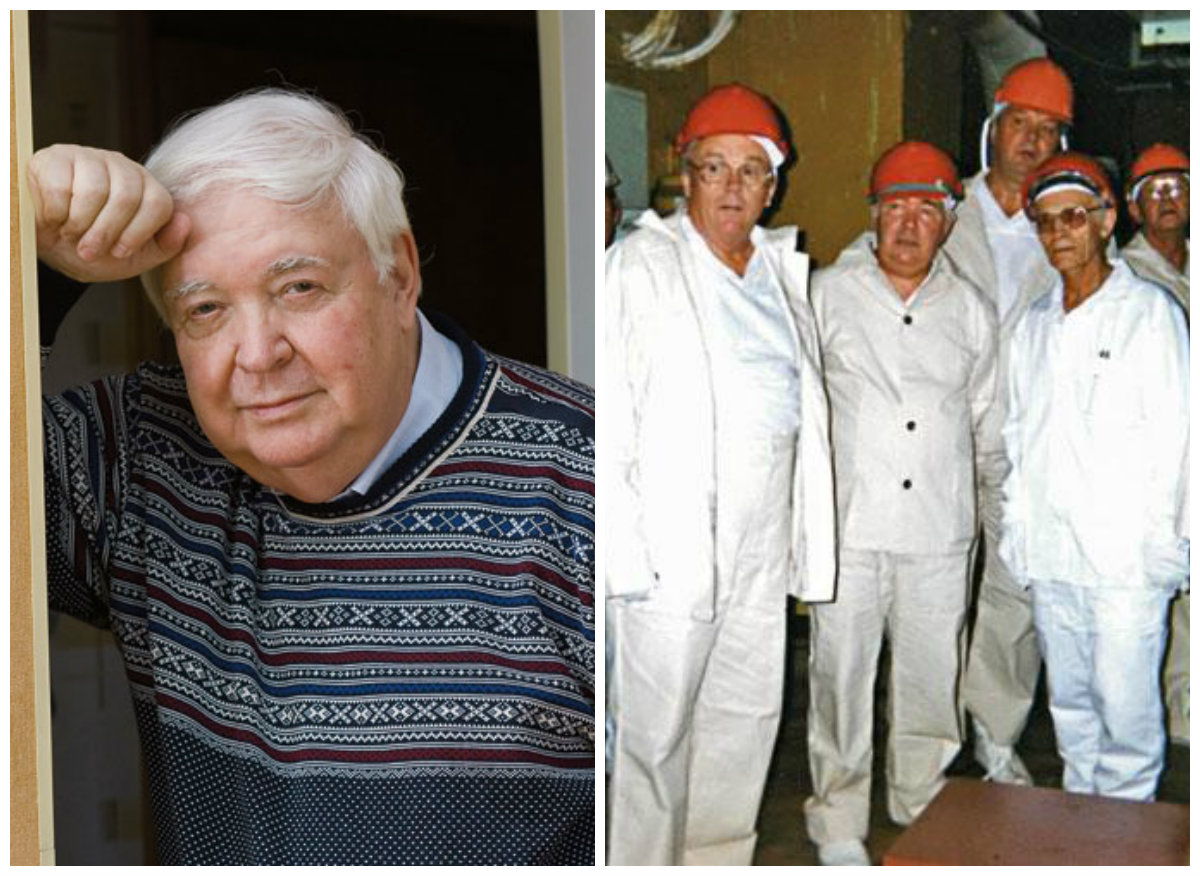 Photo:Itogi
Photo:Itogi
The liquidator of the Chernobyl Nuclear Power Plant, scientist Alexander Borovoy was among those for whom it became the work of his whole life. He arrived at the scene of the emergency as part of a scientific team helping the army with calculations.
Before leaving, the scientist visited his mother, who was dying of cancer. She remembered that Chernobyl is a type of steppe wormwood, and asked to read a passage from the Bible, which would later be called prophetic:
“A large star fell from the sky, burning like a lamp, and fell on a third of the rivers and springs of water. Its name is wormwood.”
Hearing these lines, the dying mother let him go.
“You can’t escape fate, your place is there. Chernobyl is your star,” these were her words.
Work on the concreted “Shelter” did not continue even in the 90s. And all this time, the scientist was continuously on guard of radiation safety, writes the Argument portal.
A forgotten feat of a fireman
The liquidators of the Chernobyl accident are people who did not seek glory, they fought an invisible enemy in the name of the country. That is why few people know about the feat performed by firefighters a month after the ill-fated April 26, 1986.
On the night of May 23 in the premises circulation pumps An extensive fire broke out in the third and fourth blocks. The fire threatened to disable the third unit, which would have provoked an even more terrible man-made disaster than the explosion in the 4th power unit a month earlier.
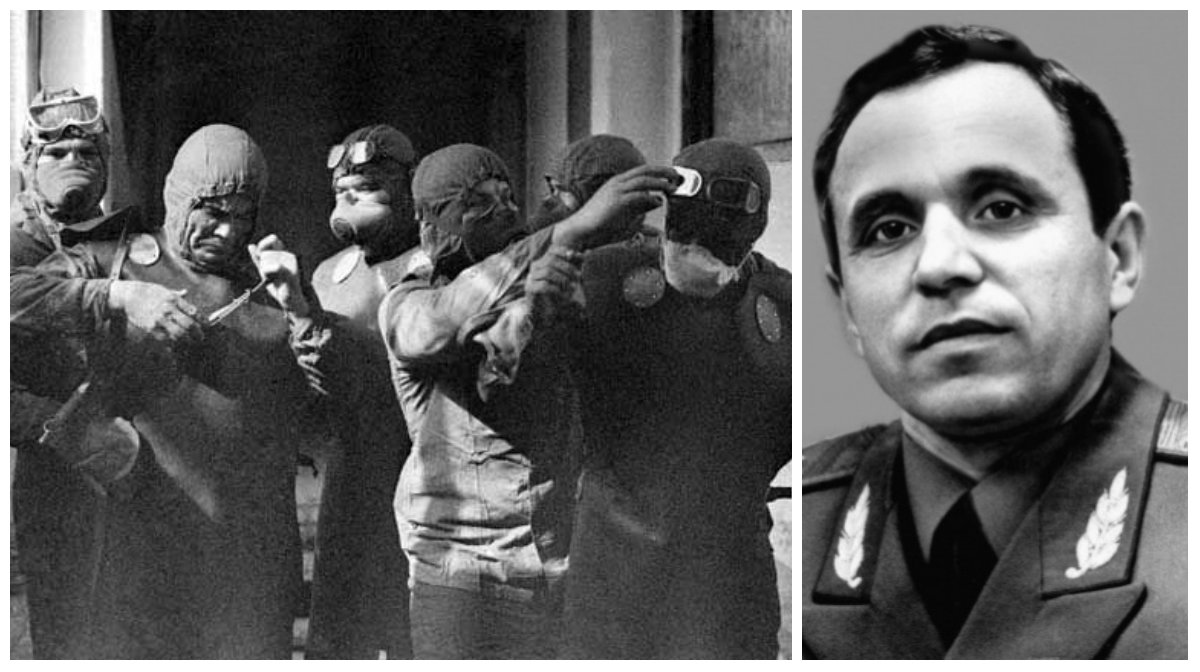 Photo:Arms-expo
Photo:Arms-expo
Lieutenant Colonel Vladimir Maksimchuk, who came to lead the hastily assembled fire brigades, prevented the tragedy that threatened all of Europe from happening. He personally led the reconnaissance, not paying attention to the dosimeter readings and the radiation wound on his leg. Maksimchuk tried with all his might to save his subordinates by introducing shift firefighting and their delivery in armored personnel carriers. The officer himself did not dare to rest during the fire in the third block. He was taken to the hospital with radiation burns to the respiratory tract and lower leg.
For eight years, the brave fireman, who received 700 x-rays (!!!), fought the disease, continuing to serve the country, which was living its last days. He died on May 22, 1994, exactly eight years after his feat. Maksimchuk saved about three hundred lives. But it was not customary to talk about this, since the fire was classified as “secret”. Only in 2003 he was awarded the star of Hero of the Russian Federation.
Radiophobia
Oleg Alferov from the Rostov regiment 11350 said that conscript soldiers were not so much sick as they were afraid of getting sick. They were worried about possible radiation exposure and were nervous, which caused psychosis and even cardiac arrest.
![]() Photo:Disgusting men
Photo:Disgusting men
According to doctors, the liquidators of the Chernobyl nuclear power plant associated every failure in the body with radiation. People experienced extreme fear during the liquidation of the consequences of the Chernobyl accident. It is comparable to the fear of attack in war. The men suppressed fear, because next to them their comrades were playing hide and seek with death. This fear killed even after demobilization - eyewitnesses recalled this. In addition, the liquidators of the accident were “eaten up” by social injustice.
They, who heroically gave up their health for the good of the Motherland, unfortunately, were no longer noticed. Many drank themselves to death, unable to find any other use for themselves, as Rossiyskaya Gazeta writes about.
On this day, April 26, 2016, I would like to wish long life to those who, without sparing themselves, fulfilled a duty that we, contemporaries, would have dared to undertake, to put it mildly, with difficulty...
30 years ago, on April 26, 1986, an accident occurred at the Chernobyl nuclear power plant. An explosion occurred at the fourth power unit. The reactor was completely destroyed, a radioactive cloud covered a large territory of Ukraine, Belarus, and Russia - more than 200 thousand square kilometers. The accident is regarded as the largest of its kind in the entire history of nuclear energy. 600,000 people are recognized as liquidators of the Chernobyl accident.
Five liquidators from those who were the first to fight the fire at the Chernobyl Nuclear Power Plant were posthumously awarded the Hero of Ukraine
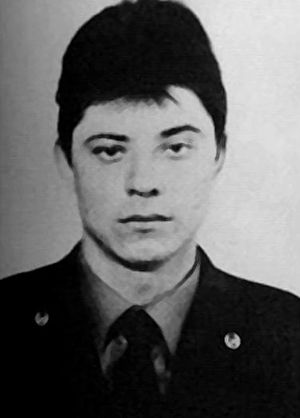
Nikolay Vashchuk, commander His department laid a fire hose on the roof of the Chernobyl nuclear power plant. He worked at high altitude in conditions high level radiation, temperature and smoke. Thanks to the determination of firefighters, the spread of fire towards the third power unit was stopped.
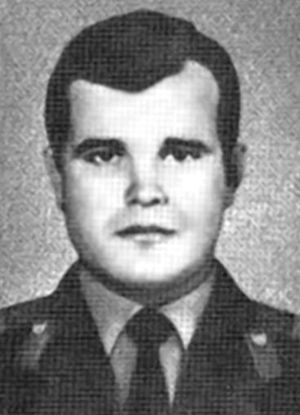
Vasily Ignatenko, commander He was among the first to climb onto the roof of the burning reactor. The fires were fought at high altitudes - from 27 to 71.5 m. Vasily carried Nikolai Vashchuk, Nikolai Titenko and Vladimir Tishura out of the fire when they lost consciousness due to high radiation.
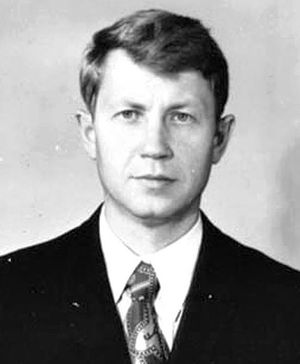
Alexander Lelechenko, Deputy Head of the Electrical Shop at the Chernobyl Nuclear Power Plant. After the explosion, to protect the young electricians, he himself went to the electrolysis shop three times. If he had not turned off the equipment, the station would have exploded like a hydrogen bomb. Having received medical assistance, he asked the doctors for time off for some fresh air, and he himself ran to the power unit to help his comrades again.
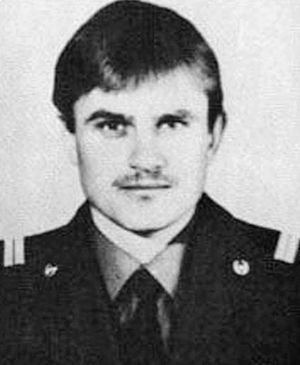
Nikolay Titenok, firefighter. Without the slightest idea of what awaited him, he arrived, like his comrades, in sleeveless jackets, without any protection from radiation. He threw away pieces of radioactive graphite with boots and canvas mittens. Because of high temperature Firefighters removed their gas masks within the first 10 minutes. Without such dedication, the radiation release would have been much greater.
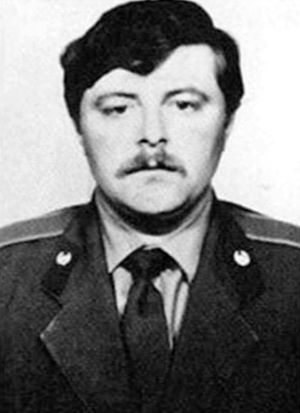
Vladimir Tishura, senior firefighter. I was among those who extinguished the reactor hall - there was a maximum level of radiation here. Within half an hour, the first injured firefighters appeared. They began to experience vomiting, “nuclear tanning,” and the skin was peeling off their hands. They received doses of about 1000-2000 microR/hour or more (the norm is up to 25 microR).
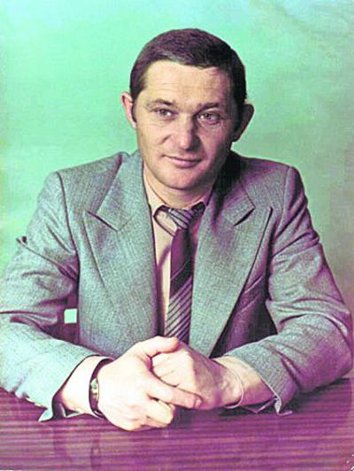
Survived a lethal dose
Leonid Telyatnikov
In 1986, Leonid Telyatnikov worked as the chief of the fire department at the Chernobyl nuclear power plant. Within a few minutes after the explosion, he and a team of 29 firefighters rushed to the station. “I had absolutely no idea what happened and what awaited us,” he recalled. - But when we arrived at the station, I saw the ruins covered in flashes of lights reminiscent of sparklers. Then I noticed a bluish glow over the ruins of the fourth reactor and spots of fire on the surrounding buildings. This silence and the flickering lights gave me an eerie feeling.” Realizing the danger, Telyatnikov twice climbed to the roof of the turbine hall and reactor compartment to extinguish the fire. This was the highest and most dangerous point. Thanks to the fact that Telyatnikov, as a leader, set the tasks correctly and chose the location of the fire trucks, the fire did not spread to neighboring blocks and was extinguished. The liquidators felt the effects of high levels of radiation right at the fire. “My father told me that he barely got down from the roof of the reactor the second time, he felt so bad,” the hero’s son Oleg Telyatnikov told us. Leonid received a radiation dose of 520 rem - almost fatal, but survived. In September 1986, 37-year-old Telyatnikov was awarded the title Hero Soviet Union, awarded the Order of Lenin. He died in December 2004.
Firefighters entered into a deadly battle with the fire. Just seven minutes after the alarm signal, fire crews arrived at the nuclear power plant. They were commanded by Major of the Internal Service Leonid Petrovich Telyatnikov. Next to him in the first ranks of firefighters were the commanders of the fire watch, 23-year-old lieutenants of the internal service Viktor Nikolaevich Kibenok and Vladimir Pavlovich Pravik. By their example, they captivated the fighters, gave clear commands, and went where it was most dangerous. The firefighters accomplished a real feat - they averted trouble and saved thousands human lives. But the dose of radiation that the brave officers received turned out to be very high.
Lieutenants Viktor Kibenko and Vladimir Pravik were posthumously awarded the title of Hero of the Soviet Union.
Leonid Telyatnikov was also awarded the Gold Star of the Hero. After treatment, he continued his service and became a general. But the disease did not subside. The hero passed away in 2004.
Let's return again to the tragic days of Chernobyl. How did things turn out after the first fiery strike was repelled? The fire fighters continued their military work. Combined detachments from fire departments throughout the country took over the watch at the firing line. Their actions were supervised by a lieutenant colonel of the internal service, head of the operational-tactical department of the Main Directorate for Promotion of the Ministry of Internal Affairs of the USSR, Vladimir Mikhailovich Maksimchuk.
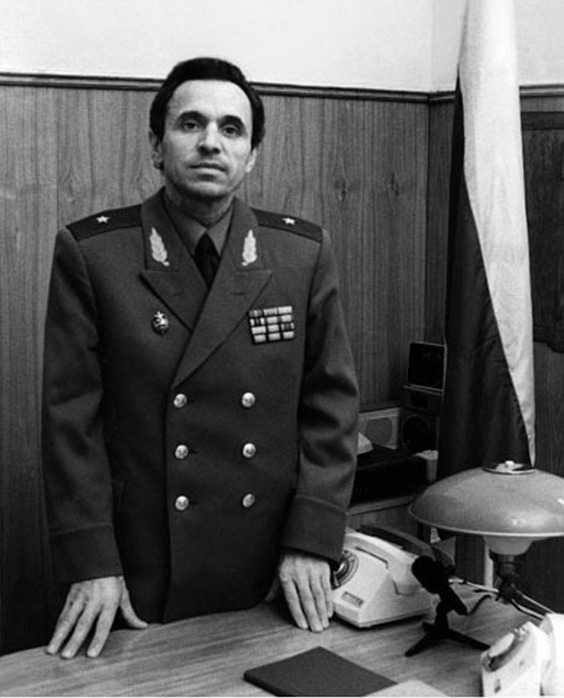
On the night of May 23, 1986, the Chernobyl Nuclear Power Plant re-emerged. dangerous situation. The fire that broke out reached the machine room, filled with tons of oil, and the pipelines where there was hydrogen. The slightest delay could lead to stopping the pumps and leaving the third unit of the Chernobyl Nuclear Power Plant, which threatened terrible disaster. Its consequences would have been much more serious than the consequences of the April 26 disaster. Having assessed the situation, Maksimchuk chose the only correct extinguishing method in that situation: firefighters entered the danger zone in teams of five people, worked there for no more than 10 minutes, and then they were immediately replaced by another team. Vladimir Mikhailovich himself took a personal part in reconnaissance of the source of the fire, then did not leave the fire zone for almost 12 hours and, already giving his last strength, made the calculation of the foam attack, which finished off the remaining sources of fire. The skillful actions of Vladimir Maksimchuk saved people (more than three hundred people!), the station and, as they say, half the planet. The tactics he proposed for extinguishing fires at nuclear facilities had no analogues before and subsequently became the property of the world firefighting community. Later, doctors determined: during these dramatic hours, Lieutenant Colonel Maksimchuk received an ultra-high dose of radiation - about 700 roentgens. He was taken to the Ministry of Internal Affairs hospital in Kyiv with severe radiation burns to his leg and respiratory tract. Information about what happened was classified, and the commander’s feat was not assessed in a timely manner... Vladimir Mikhailovich faced a death sentence for eight whole years, but he did not lose optimism, continued to work painstakingly, achieve his goals, while, just as before, he often took risks with your life. In 1987, it was Vladimir Maksimchuk who led the extinguishing of the most complex fire in the Rossiya Hotel in Moscow, and in 1988, the extinguishing of the fire on the Ural - Western Siberia. In 1989, he supervised the elimination of a large fire at a chemical plant in the Lithuanian city of Jonava, where he used tactics worked out in Chernobyl. And then - despite the most severe and painful illness (thyroid cancer and stomach cancer), which progressed since 1989 as a result of radiation at Chernobyl, having undergone several complex operations, he continued to do great things. In 1990, Vladimir Maksimchuk was awarded the rank of “Major General of Internal Service”, and in the same year he was appointed to the post of First Deputy Head of the Main Fire Department of the USSR Ministry of Internal Affairs. Having experience of extinguishing fires in Chernobyl, Jonava, and other “hot spots” of the USSR, an extraordinary personality, a major specialist, an altruist and a fan of firefighting becomes the initiator of the creation of an effective national system of safety and combating accidents, catastrophes and natural disasters - the domestic emergency service responding to emergencies. Thanks to his perseverance and personal participation in the country, the foundation of the emergency rescue service was laid - in the structure of the fire department, a network of specialized teams was created to carry out priority rescue work (which became the prototype of the modern Ministry of Emergency Situations of Russia), the production of the latest fire equipment, fire-technical weapons and emergency rescue equipment. In 1992 he headed fire department Moscow, where a radical revolution was carried out in the work of the service: the first helicopter fire and rescue service in Russia, a special squad for extinguishing large and most dangerous fires, fire departments received modern rescue equipment, opened The educational center for the training of fire specialists, the “01” service has been completely modernized. The last feat of the brave firefighter was the quick extinguishing of the White House and Moscow City Hall buildings after the tragic events in October 1993. On May 22, 1994, Vladimir Mikhailovich passed away. Named after the fearless officer: a school in his homeland, a fire boat in Moscow, a specialized fire Department N2, where he began his service in Moscow, Moscow Technical Fire and Rescue College No. 57. Since 1994, international competitions in fire-applied sports for the General Maksimchuk Cup have been held. In 2003, by presidential decree Russian Federation Vladimir Mikhailovich Maksimchuk was posthumously awarded the title of Hero of Russia.
The feat of the Chernobyl heroes will always serve as an example of courage, the highest professionalism and fidelity to duty for Russian and Ukrainian firefighters.
Antonova Yulia
Directorate for Higher Administrative District of the Main Directorate of the Ministry of Emergency Situations of Russia for Moscow
Image caption Widow of Chernobyl NPP operator Valery Khodymchuk Natalya
For more than 20 years, Kiev resident Natalya Khodymchuk traveled to Moscow on April 26 to the Mitinskoe cemetery to the memorial to those killed in the Chernobyl accident.
There is the grave of her husband, Valery Khodymchuk, an operator of the Chernobyl nuclear power plant reactor shop.
The hill is symbolic. When an explosion occurred at the fourth power unit of the Chernobyl nuclear power plant on the night of April 26, 1986, Valery was in the turbine hall of the station. His body was never found under the rubble of the station.
“I would like to know how he died. It still worries me, although 29 years have passed. But I will never know,” says the woman.
However, this year the trip of relatives of those killed in the Chernobyl accident to the Mitinskoe cemetery in Moscow was canceled due to the situation in relations between Ukraine and Russia.
“In recent years, the Chernobyl Union of Russia has helped us organize the trip. But now we will not take money from Russia,” says Alexander Zelentsov, chairman of the Chernobyl disabled people’s organization Luch 5-2.
"Ray 5-2" brings together relatives of those who died from radiation sickness after the Chernobyl accident. Mr. Zelentsov notes that on April 26, instead of the Mitinsky cemetery, relatives go to the Chernobyl church in Kyiv.
Cemetery under concrete
At the Mitinskoye cemetery in Moscow there are 30 graves of the first victims of the Chernobyl accident - these are firefighters who were the first to go to extinguish the fire, and workers of the nuclear power plant.
Most of them died from radiation sickness in the 6th Clinical Hospital of Moscow in the first months after the tragedy - in May-July 1986.
Image caption Relatives of those killed in the Chernobyl accident at the Mitinskoye cemetery in Moscow (photo from the Khodymchukov family archive)During the funeral at the Mitinskoye cemetery, special security measures were observed, says Anna Korolevskaya, deputy director of the National Chernobyl Museum.
The Chernobyl Museum stores declassified documents, maps, photographs and memories of participants in those events.
“The bodies were first wrapped in film, then placed in a wooden coffin, then the wooden coffin was wrapped in film, and then all this was sealed in a zinc coffin and buried,” says Ms. Korolevskaya.
Later, she said, the burial site was filled with concrete. Among these 30 graves, three are symbolic. One of them is engineer Vladimir Shashenok.
After the accident, Shashenok, according to eyewitnesses, received such severe burns from radioactive steam that the person who carried him out of the station after the accident had a burn on his body.
Vladimir Shashenok died at dawn on April 26. He was buried in the cemetery in the village of Chistogalovka, next to the station.
Another one of the first victims of the Chernobyl accident was the deputy head of the Chernobyl electrical shop, Alexander Lelechenko.
"He escaped from the Pripyat hospital and returned to the station. Lelechenko understood that he had received a large dose of radiation, but continued to work as long as he could, to eliminate the accident. He was already treated here in Kyiv. But they could not save him. He received a large dose of radiation - more than 1500 thousand roentgens, and 700 roentgens are lethal,” says Anna Korolevskaya.
Alexander Lelechenko died of radiation sickness in Kyiv on May 7, 1986. At the Mitinsky cemetery they installed a symbolic grave for him next to everyone else.
Of the 12 personnel in the Chernobyl turbine hall who were on shift on the night of April 26, eight died from radiation sickness, says a representative of the Chernobyl Museum.
“Firefighters fought the accident outside, and inside the premises of the fourth power unit, the station staff fought the accident and the fires that broke out there, in the conditions of a pipeline rupture, when oil was boiling around there, there was radioactive steam,” says Ms. Korolevskaya.
Image caption Memorial plaque to Valery Khodymchuk in the third power unit of the Chernobyl nuclear power plantThe Chernobyl nuclear power plant is another place where Natalya Khodymchuk honors the memory of her deceased husband.
“I go to Chernobyl to see Valera every year on March 24 on his birthday. He still lies there,” the woman says, sighing.
Dedicated to the memory of the heroes-liquidators of the Chernobyl accident!
For the majority of the younger generation, the word “Liquidator” is associated with American blockbusters and action films. But the older and mature generations remember the one who is called, to this day, the “liquidator,” whom they can and should be proud of!
On the night of April 25-26, 1986, at 1:23 am, one of the most terrible man-made disasters in the history of our country - the Chernobyl tragedy - occurred at the 4th block of the Chernobyl nuclear power plant.
April 26 marks the 25th anniversary of the explosion at the nuclear power plant. In our country, more than 530 thousand people (including 175 thousand liquidators) received “doses”. Firefighters worked at enormous heights, among the ruins and debris of the exploded reactor, with their heroic efforts they struggled in this most difficult situation. Knights without fear and reproach, how could any of the ignorant people offer such a great feat, such self-sacrifice in the name of others, were they capable, these ordinary and invisible Everyday life guys!
This is a story about a fireman, about one of those who took the first blow of the terrible fiery and radioactive elements!
At 1:24 a.m., the control panel of the 2nd militarized fire department of the Internal Affairs Directorate of the Kyiv Regional Executive Committee for the Protection of the Chernobyl Nuclear Power Plant received a signal about a fire. The fire department duty guard (in a ZIL-131) headed by internal service lieutenant Vladimir Pavlovich Pravik arrived at the station. The guard of the 1st paramilitary fire department of the Department of Internal Affairs of the Kyiv Regional Executive Committee for the Protection of the Chernobyl Nuclear Power Plant, led by Lieutenant Viktor Nikolaevich Kibenko, came to the rescue. Lieutenant Pravik took charge of extinguishing the fire. His competent actions prevented the spread of the fire. Additional reinforcements were called from Kyiv and surrounding areas. The only protective equipment the firefighters had was a canvas uniform (combat jacket), mittens, and a helmet. The GZDS units were wearing KIP-5 gas masks. By 2.30 Major Leonid Telyatnikov arrived and became RTP. By 4 o'clock in the morning the fire was localized on the roof of the turbine room, and by 6 o'clock in the morning it was extinguished. The presence of a high level of radiation was reliably established only by 3:30, since of the two available devices for 1000 roentgens per hour, one was out of order, and the other was inaccessible due to the rubble that had arisen. Therefore, in the first hours of the accident, the real levels of radiation in the premises of the block and around it were unknown. The state of the reactor was also unclear. From operational information: during the first hours of the fire fight, the fire was concentrated in danger zone 37 fire departments, 240 people, 81 units of fire equipment. In the first hours after the accident, many apparently did not realize how badly damaged the reactor was, so the mistaken decision was made to supply water to the reactor core to cool it. This required work in areas with high radiation. These efforts were useless, as both the pipelines and the core itself were destroyed. Other actions of the station personnel, such as extinguishing fires in the station premises and measures aimed at preventing a possible explosion, on the contrary, were necessary. They may have prevented even more serious consequences. While performing these works, many station employees received large doses of radiation, some even fatal. In 3 room apartment Viktor Semenovich Birkun in the city of Pripyat, where he lived with his wife Nadezhda Vladimirovna and two daughters, at night, April 26, 1986, they knocked insistently and for a long time. Viktor Semenovich did not have time to reach the door, his wife got ahead of him and asked: “Who’s there?” “The police!” The time on the alarm clock was 1 hour 40 minutes at night. Viktor Semenovich recognized the voice of the assistant on duty, who said that he needed to come to work immediately.
Birkun V.S. I hurriedly ran down to the police UAZ and saw a huge glow and smoke above the nuclear power plant, which was guarded by their militarized fire department. For an experienced firefighter who has seen various types of fires, such a glow in the form of a hellish glow is incomparable to anything.
At a nuclear power plant, firefighters have their own professional training, at which, along with the HPV officers, classes on topics were conducted by leading specialists of the nuclear power plant. The picture they saw frightened even seasoned firefighters: there was still fire everywhere, but the glow? Appearing on the threshold of the fireplace, the dispatcher reported the call number, which called for forces and resources from Kyiv and the entire region to gather at the scene of the fire. By the 4th block it took two turns, the head of the HPV Leonid Petrovich Telyatnikov ordered to call you in a PNS car. Victor knew that Telyatnikov had to finish his vacation while he was already there at the reactor fire. Viktor Semenovich was given the task of installing the pumping station on the water pipeline to block 4. Along the way, Victor did not recognize the ruins of block 4, in his fire truck pumping station rushed among the fragments of concrete and piles of twisted iron, pieces of concrete and metal structures, thrown out by monstrous force. We had to drive around a lot, ram the car and crush the smaller pieces of the ruins. In addition to the building on fire, there were dozens of other fires. The roof of the turbine hall was burning, molten asphalt, bitumen, metal was melting... There was a threat that the fire would spread to the third block of the nuclear power plant, to transformer substations. All the firefighters on duty and those off shift who came to help fought the fiery elements, not thinking about invisible radiation, which was much worse than fire. Before block 4, approximately 60-70 meters remained, the chiefs of guards No. 1 and No. 2 Petr Khmel and Valery Datsko, HPV inspector Yuri Khilko, senior lieutenant Petr Shavriy, and helped connect the PNS, arrived to the car. The second foam vehicle was brought up by the squad commander Vasily Bulava and both vehicles were paired, feeding foam 75 meters upward into the center of fire. The PNS worked without failure. Looking at the clock, the time was 2 minutes, listening to the walkie-talkie, I had to follow the commands of the head of the HPV Telyatnikov more, less speed. The height is 75 meters, this is the mark at which the firefighters worked with all their might, even more than they could do themselves.
During one of the pauses, Viktor Semenovich examined the ZIL (the pumps continued to work confidently). Seeing a thick metal rod stuck between the tires. Birkun Viktor Semenovich began to pull out the reinforcement with his bare hands, not knowing the consequences, because the equipment must be handed over to the replacement in good condition, so that it can be returned to the unit’s location.
And it turns out that this piece of iron was highly radioactive, just like the area in the affected area. In any fire department, there are both gloves and gas masks (it, of course, does not protect against radiation, but does not allow you to inhale contaminated dust). However, no one warned the firefighters that the fire was unusual and involved the release of radiation. By the way, no training was carried out to extinguish such a fire at the Chernobyl nuclear power plant. During the exercises, a fictitious “fire” on the roof, “burning” transformers, and cables were extinguished, but there was never any talk about an explosion of a nuclear reactor. Birkun Viktor Semenovich once asked, what if a nuclear boiler explodes? The nuclear power plant specialist confidently answered: “This is basically impossible, 100 percent guarantee.”
It was very difficult to drag the damn rod stuck between the wheels. I had to squeeze it with my palms as hard as I could. Someone passing by said to Viktor Semenovich: “Give it up.” But stubbornly, continuing to pull, I managed to do it. Did you think in those critical moments what was going on around you, how the tragedy would turn out, that up there Volodya Pravik, Vitya Kibenok, Telyatnikov, and he himself, Victor, here on earth, other firefighters were receiving monstrous doses of radiation? During the work, no one thought about the damage, the countless victims and how this tragedy would turn out for everyone, both for the liquidators and for the country as a whole.
While in the car it was four o'clock and I was horrified - my hands began to turn black. And about twenty minutes later, Birkun Vladimir Semenovich felt nauseated. Vomiting began. Then again and again... The attacks became more and more severe and unbearable. The stomach had been empty for a long time, nevertheless, the whole body was turned inside out. My stomach muscles hurt terribly. You feel your strength draining away and becoming weaker every minute. Sitting on a stone...
On the radio I heard: “Semyonich, turn everything off, come back, go to the sanitary inspection room. The shift is coming.” It was no longer possible to get up; there was no strength to walk due to the effects of radiation. Viktor Semenovich could not get up. He just clutched the receiver of the radio in his hand. Having gathered his last strength, he answered on the radio: “I don’t know what happened, but my legs don’t obey me, I can’t walk and it’s even difficult to talk on the radio.” The guys quickly arrived, lifted Viktor Semenovich by the hands into the cabin, and took him to main building, and from there by ambulance to the medical unit.
Based on the thyroid gland and pupils, doctors diagnosed him with radiation sickness. Later, Birkun Viktor Semenovich, like his colleagues, ended up in the hospital. Even after more than 20 years, Viktor Semenovich does not remember everything that happened - at some moments his consciousness became cloudy, his head was splitting. I remember how the radiation counters rang furiously near Viktor Semenovich Birkun - and he himself “glowed” so that it was dangerous for anyone to be near...
On a special flight, Telyatnikov, Pravik, Kibenko, Khmel, Butrienko, Birkun, Tishura, Ignatenko will be delivered to Moscow. And there...the struggle for life began. Bone marrow transplantation was considered almost a panacea for all ills, and they relied on American authorities.
A doctor, Candidate of Medical Sciences Sara Borisovna Khanina came to Viktor Semenovich’s room, she admitted: “You are like a son to me.” You tough guy. You must live! Now they will come to you for consent for a bone marrow transplant. But Viktor Semenovich sensed Sara Borisovna’s doubts and refused the operation.
In such painful moments, despair often sets in. I have to stay awake at night, I was spoon fed. Following the hands, the legs began to turn black. He lay in bandages, like in a cocoon, with only slits for the eyes and mouth. Victor lay in the room, and the tears flowed. “It’s all gone,” I thought, but then: “at least live for a year to start a family.”
Meeting with fellow sufferers in the hospital, they reconstructed the picture of what they had experienced. The insulation, roofing felt, bitumen, turbine oil, plastic compound, and cables that caught fire during the explosion emitted a large amount of toxic smoke. Circumstances and environment created a situation of real hell. In addition, we had to work at high altitudes with the threat of collapse building structures, but most importantly in powerful fields of ionizing radiation.
It takes great courage to reason in such situations. The soldier who was assigned to serve them once said: “Is your governor?” - Yes. Pravik died. And so it went. In sequence.
Somehow the assigned soldier decided to please: Birkun Viktor Semenovich: - my wife and daughter have arrived. But they are not allowed in, they stand in the yard. Approaching the window, I saw my relatives and asked the soldier to go down to them and ask them what and how. The returning intermediary brought bad news. Victor’s family was taken out, like all the residents of the city of Pripyatik, where, every single one of them, they put them on buses, cars, no matter what they were wearing, without personal belongings. They are in the Moscow region with relatives. An interest in life that glows in the wild like a coal in a doused fire. You inflate it a little and it flares up little by little.
In the Izvestia newspaper what the soldier brought about Vasily Ignatenko, Vasily Bulaev, Ivan Butrimenko, Vladimir Tishur, Ivan Shavrey, Nikolai Tytenko, Vladimir Prishchepa, Alexander Petrovsky. - large material with photographs: Eternal memory to them. The same newspaper writes about Telyatnikov.
Viktor Semenovich did not immediately feel a turning point in his condition and recovery. As soon as he got stronger, he asked to go to work, and again to the fire department. Fate decreed that he ended up in the Moscow region in PCH-82 in Lobnya, where he continued to serve until retirement, in the same position as a fire truck driver.
Leonid Petrovich Telyatnikov was awarded the title of Hero of the USSR. Vladimir Pavlovich Pravik and Viktor Nikolaevich Kibenok were awarded the gold star posthumously. Birkun Viktor Semenovich was awarded the Order of the Red Banner.
Viktor Semenovich survived. He survived, but his stay in the radiation-fiery hell left a heavy mark on his body. Judging by the official document, the radiation dose he received was 260 rem (the permissible limit according to the standards in force before 1999 was 5 rem per year, which is equivalent to 5 roentgens). That is, Birkun received the maximum permissible portions of radiation in just 52 years. Viktor Semenovich himself believes that these figures are greatly underestimated and in fact he grabbed not 260, but 400 rem. Be that as it may, the doctors made serious clinical diagnoses: “Acute radiation sickness (ARS) of the 2nd degree of severity. Radiation burns of the hands, legs, buttocks of the 1st-2nd degree. Radiation cataract of the 1st degree.” And also diabetes, hypertension, angina pectoris, atherosclerosis, sensorineural hearing loss and other diseases. He underwent operations, including on the thyroid gland. I constantly suffer from severe headaches, dizziness, cramps...
Treatment requires not only expensive drugs (and many of the drugs he needs on the preferential list, alas, have long since disappeared), but also good food, expensive fruits and vegetables. The pension is miserable, it’s only enough to pay for the apartment. Are these the pennies that the liquidator is entitled to? The role of the government at the time of the accident was clear and no effort or resources were spared. Only the program for the rehabilitation and recovery of the consequences of the Chernobyl tragedy participants was designed for only 10 years. During these 10 years, not a single liquidator should have survived, and those who survived have a chance to live out their term.
Viktor Semenovich’s endless litigation with the bureaucratic attitude of officials only undermined the already “shaky” health of the liquidator.
At the end of December 2010, Viktor Semenovich said that he was lying on the operating table and the operation would be on the heart. On February 15, 2011, while in an induced coma, Viktor Semenovich turned 61 years old, and already on February 16, 2011, the liquidator’s heart stopped. Eternal memory to the heroes!
Recording of the first conversations of the Chernobyl nuclear power plant dispatcher
On April 26, 1986, when the reactor of the 4th block of the Chernobyl nuclear power plant was already lying in ruins, fire department commander L.P. Telyatnikov was on vacation and was supposed to go to work only on the 28th. He and his brother were celebrating his birthday when a phone call came from the depot. Immediately leaving everything behind and arriving at the scene of the fire at the 4th block of the Chernobyl Nuclear Power Plant, Leonid Petrovich immediately saw that he needed to ask for help from wherever possible, since there were very few people on site. He immediately ordered Lieutenant Pravik to urgently transfer call No. 3 to the region, which he did. On call No. 3, all fire trucks in the Kyiv region, no matter where they were, urgently had to move to the Chernobyl nuclear power plant.
Meanwhile, firefighters Chavreuil and Petrovsky were already on the roof of the turbine room, to whose gaze a fiery and smoky barrage opened up. Soldiers from the sixth unit were walking towards them, their condition getting worse every minute. They helped them reach the stairs, along which they climbed to the roof, and they themselves rushed to put out the flames.
Firefighter Prishchepa connected the hoses to the hydrant and, together with his comrades, climbed onto the roof of the turbine room of the 4th block of the Chernobyl nuclear power plant. When we climbed in, we saw that in some places there was no overlap. Several slabs fell down, while others still lay in their places, but honestly, and it was dangerous to walk on them. Prishchepa was forced to go down again to warn his comrades, where he met Major Telyatnikov. Together we decided to set up a duty post and not leave it until complete victory over the fire.
Until five in the morning, Prishchepa, together with Shavrey and Petrovsky, fought the fire on the roof of the turbine room, until it got really bad. Actually, it became bad almost immediately, but the firefighters considered it a consequence of the heat and acrid smoke from the burning bitumen and endured it. But by morning, when the fire on the roof of the turbine hall had already been extinguished, it became very bad, and they decided to go down to the ground.
Pravik’s men were sent in full force to extinguish the roof of the turbine hall, as they were the first to arrive at the scene. Kibenko's crew, who arrived a little later, was tasked with putting out the fire in the reactor compartment, where the fire was raging at different levels. In the central hall, flames raged in five places at once. Kibenok, Vashchuk, Ignatenko, Titenko and Tishchura began to extinguish these centers of radioactive fiery hell. When the fire in the reactor hall of the 4th block of the Chernobyl nuclear power plant and the separator rooms was completely extinguished, only one most powerful and dangerous source remained - the reactor. Firefighters sent several fire hoses into the buzzing active zone, but the water was powerless. Can you extinguish 190 tons of hot radioactive uranium with water? It’s like trying to put out a Pioneer fire out of little need.
While Telyatnikov was absent, Lieutenant Pravik repeatedly climbed to the roof of block “B” to see the fire’s reaction to the efforts made by firefighters and determine further tactics to combat the elements, and also approached the reactor several times.
When Telyatnikov arrived at the Chernobyl Nuclear Power Plant, Pravik took on the function of his first assistant.
First it was necessary to stop the fire in the main directions. Telyatnikov sent one crew of firefighters to extinguish the fire in the turbine room, while the other two fought the bubbling flames on the approach to the neighboring third block of the Chernobyl nuclear power plant. They also put out several fires in the central hall.
The situation changed every minute, so Telyatnikov himself rose to the seventy-first mark several times to control the direction of the fire. Heavy toxic smoke from burning bitumen obscured the eyes and caused a hysterical cough, and those displaced by the explosion from their places concrete structures the coatings threatened to collapse into a nuclear hell at any moment. A total of 37 fires were extinguished on the roof of the turbine room and in the reactor room.
Molten bitumen stuck to boots, smoke corroded the eyes, and black radioactive ash from burning graphite fell onto helmets from above. Leonid Shavrey was on duty on the roof of block “B” and made sure that the fire did not spread further. It was unbearably hot both outside and inside, so Chavreuil even took off his helmet, trying to catch his breath. The cough was choking, my chest was pressing from the inside, I couldn’t breathe. Nobody thought seriously about radiation back then. But by the morning, one after another, with clouding of consciousness, nausea and vomiting, people began to break down.
It was half past three when Telyatnikov went down to the control panel to Akimov to report the situation on the roof. He said that people are getting sick, isn't it because of radiation? A dosimetrist was called. Gorbachenko came, said that the radiation levels in the territory had not been fully clarified, and gave Pshenichnikov to help. Together they headed to the staircase and elevator block to get out to the roof through the door at the top, but the door was closed. The break-in attempt was unsuccessful, and there was nothing left to do but go downstairs and go outside. Stumbling over pieces of graphite, we walked around the building of the 4th block.
Telyatnikov was already very ill at that time, but he was guilty of smoke poisoning and the high temperature that he had to experience while putting out the fire. Pshenichnikov had a radiometer with him, but it was capable of measuring no more than 4 roentgens per hour. Everywhere, both at the roof level and at the zero level, the device went off scale; the exact radiation levels could not be determined. Later, experts established that on the roof in different places there were from 2 thousand to 15 thousand roentgens per hour. Actually, the fire on the roof broke out due to hot fuel and graphite falling on it. The molten bitumen flared up with a bright flame, and firefighters walked through this nuclear-fire mess in tarpaulin boots. Below, however, it was no better. Highly radioactive nuclear dust, released from the inside of the reactor, covered everything around with a toxic coating.
Kibenok and his boys were the first to go out of action, and a little later Lieutenant Pravik joined them. However, by five in the morning all the flames had been extinguished. A high price had to be paid for the victory over the elements. Seventeen firefighters were sent first to the medical unit, and in the evening of the same day by plane to Moscow. Fifty fire engines from Chernobyl and other areas of the Kyiv region arrived at the scene of the accident to help. But by this time the most dangerous work had already been completed.
FIVE LIQUIDATORS FROM THOSE WHO FIRST ENTERED THE BATTLE WITH THE FIRE AT THE Chornobyl Nuclear Power Plant RECEIVED POSTHUTOMALLY HEROES OF UKRAINE:
Nikolay Vashchuk, commander. His department laid a fire hose on the roof of the Chernobyl nuclear power plant. He worked at high altitude in conditions of high levels of radiation, temperature and smoke. Thanks to the determination of firefighters, the spread of fire towards the third power unit was stopped.
Vasily Ignatenko, commander He was among the first to climb onto the roof of the burning reactor. The fires were fought at high altitudes - from 27 to 71.5 m. Vasily carried Nikolai Vashchuk, Nikolai Titenko and Vladimir Tishura out of the fire when they lost consciousness due to high radiation.
Alexander Lelechenko, Deputy Head of the Electrical Shop at the Chernobyl Nuclear Power Plant. After the explosion, to protect the young electricians, he himself went to the electrolysis shop three times. If he had not turned off the equipment, the station would have exploded like a hydrogen bomb. Having received medical assistance, he asked the doctors for time off for some fresh air, and he himself ran to the power unit to help his comrades again.
Nikolai Titenok, firefighter. Without the slightest idea of what awaited him, he arrived, like his comrades, in sleeveless jackets, without any protection from radiation. He threw away pieces of radioactive graphite with boots and canvas mittens. Due to the high temperature, firefighters removed their gas masks within the first 10 minutes. Without such dedication, the radiation release would have been much greater.
Vladimir Tishura, senior firefighter. I was among those who extinguished the reactor hall - there was a maximum level of radiation here. Within half an hour, the first injured firefighters appeared. They began to experience vomiting, “nuclear tanning,” and the skin was peeling off their hands. They received doses of about 1000-2000 μR/hour or more (the norm is up to 25 μR).
SURVIVED A FATAL DOSAGE:
In 1986 Leonid Telyatnikov worked as chief of the fire department at the Chernobyl nuclear power plant. Within a few minutes after the explosion, he and a team of 29 firefighters rushed to the station. “I had absolutely no idea what happened and what awaited us,” he recalled. “But when we arrived at the station, I saw the ruins covered in flashes of lights reminiscent of sparklers. Then I noticed a bluish glow over the ruins of the fourth reactor and spots of fire on the surrounding buildings. This silence and the flickering lights gave me an eerie feeling.” Realizing the danger, Telyatnikov twice climbed to the roof of the turbine hall and reactor compartment to extinguish the fire. This was the highest and most dangerous point. Thanks to the fact that Telyatnikov, as a leader, correctly set the tasks and chose the location of the fire trucks, the fire did not spread to neighboring blocks and was extinguished. The liquidators felt the effects of high levels of radiation right at the fire. “My father told me that he barely got down from the roof of the reactor the second time, he felt so bad,” the hero’s son Oleg Telyatnikov told us. Leonid received a radiation dose of 520 rem - almost fatal, but survived. In September 1986, 37-year-old Telyatnikov was awarded the title Hero of the Soviet Union and the Order of Lenin. He died in December 2004.
Memorial to the firefighters who died during the liquidation of the Chernobyl accident
Low bow and eternal memory to the heroes-liquidators of the Chernobyl accident.




